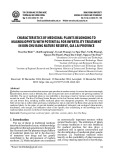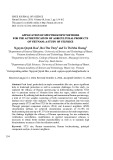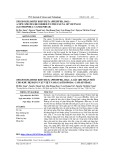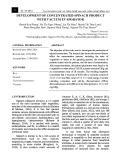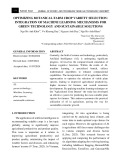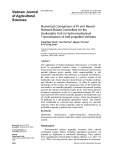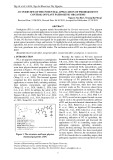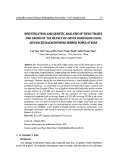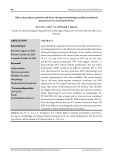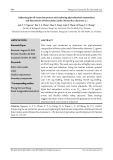
Int.J.Curr.Microbiol.App.Sci (2020) 9(4): 1908-1913
1908
Review Article https://doi.org/10.20546/ijcmas.2020.904.226
The “FAMACHA” Chart - An Alternate to Manage Haemonchosis in Small
Ruminants – A Review Article
V. Prashanth1*, H. J. Kiran2, Ram Kumar Rupner1,
Shivanagouda Patil3 and V. S. Prakash2
1ICAR-Indian Veterinary Research Institute, Izatnagar, Uttar Pradesh, India
2Veterinary College, Shivamogga – Karnataka, India
3College of Veterinary and Animal Sciences, Hisar - Haryana, India
*Corresponding author
A B S T R A C T
Introduction
In the era of anthelmintic resistance, it is the
need of the hour to look for alternative ways
of worm management. One of the most
promising approaches is to treat only the
animals which really require attention in
terms of worm management. “FAMACHA”
method has facilitated quick identification of
Haemaonchus contortus infected sheep and
goats without the aid of any laboratory
procedures and delivers the treatment only to
those who require it (Vatta et al., 2009;
Kaplan et al., 2004) and also another
International Journal of Current Microbiology and Applied Sciences
ISSN: 2319-7706 Volume 9 Number 4 (2020)
Journal homepage: http://www.ijcmas.com
Development of anthelmintic resistance has made it essential to develop
alternative ways of worm control in animals. One of the most promising
approaches is to treat only those animals which require attention in terms of worm
management. “FAMACHA” method has facilitated quick identification of
Haemaonchus contortus infected sheep and goats without the aid of any laboratory
procedures and delivers the treatment only to those who require it. The visible
signs of anaemia have been exploited as a simple and rapid diagnostic indicator
through the development of the “FAMACHA” system, which involves the
assessment of the colour of the conjunctival mucous membranes. The
“FAMACHA” system was specifically developed to identify the animals on an
individual basis which require treatment, to reduce anthelmintic resistance
imposed by the usual and frequent treatment of all animals in the group. The
“FAMACHA” chart assigns a number from 1 to 5 to each level of colour in the
eyelid. The range of colours used in the “FAMACHA” system goes from Red to
reddish pink, to pink, to pinkish-white, to white. The numbers 1 to 5 are assigned
to each of these values. The “FAMACHA” system can be a valuable tool in
helping to delay resistance issues in sheep and goat herds.
Keywords
Haemaonchus
contortus, Anaemia,
FAMACHA,
Anthelmintic
resistance
Accepted:
15 March 2020
Available Online:
10 April 2020
Article Info

Int.J.Curr.Microbiol.App.Sci (2020) 9(4): 1908-1913
1909
economic strategy for control of H. contortus.
This selective deworming strategy minimizes
the use of drugs and thereby slowing down
the development of drug-resistant. It may also
aid in selective breeding decisions by
identifying the animals that are most
susceptible to H. contortus infection.
The name “FAMACHA” was coined to
describe the system evolved for treating only
those animals unable to cope with current
Haemonchus contortus challenge on pasture,
by using clinical anaemia as the determinant.
It is an acronym (FAffa MAlan CHArt)
derived from the name of the originator of the
idea a South African scientist, Dr. Faffa
Malan (Van et al., 1997; Bath et al., 1996).
The visible signs of anaemia have been
exploited as a simple and rapid diagnostic
indicator through the development of the
“FAMACHA” system, which involves the
assessment of the colour of the conjunctival
mucous membranes (Van Wyk and Bath,
2002). For this, first animals are restrained,
and the lower eyelids are examined and
scored against a standardized set of five
colours ranging from red-pink (normal) to
white (terminal anaemia) (Malan et al., 2001).
The goal of the “FAMACHA” system is to
decrease and delay resistance by selective
deworming the animals in the herd that are
showing symptoms of parasite infection.
The “FAMACHA” system was specifically
developed to identify the animals on an
individual basis which require treatment, to
reduce anthelmintic resistance imposed by the
usual and frequent treatment of all animals in
the group. However, the classifications can
also be used as the basis for whole-flock or
herd anthelmintic treatments, when a
proportion of animals fall below a threshold
value. This approach requires frequent
assessments to ensure the early detection and
treatment of animals with subclinical
haemonchosis, with a recommended schedule
of inspections at 7 to 10-day intervals, once
anaemia is detected in a small monitor group
(Van Wyk and Bath, 2002). In addition to a
dramatic reduction in the proportion of
anthelmintic treatments given, „repeat
offender‟ animals can be identified and
culled, as there is a high heritability of
“FAMACHA” score for both sheep (Riley
and Van Wyk, 2009) and goats (Mahieu et al.,
2007).
The “FAMACHA” chart (Fig. 1) assigns a
number from 1 to 5 to each level of colour in
the eyelid. A normal eyelid of a healthy sheep
or goat is dark red, indicating that no anaemia
is present and the animal is presumed to be
free of dangerous levels of parasites. The
range of colours used in the “FAMACHA”
system goes from Red to reddish pink, to
pink, to pinkish-white, to white. The numbers
1 to 5 are assigned to each of these values,
respectively. Although some dispute remains
as to where the cut off for treatment should
be, producers generally treat animals with a
score of a 4 or a 5, and in some cases a 3.
Since goats are affected more seriously by
internal parasites than sheep, the cut-offs for
treatment in goats may be lower than in sheep
to prevent serious loss from occurring.
Treatment also depends on the class of animal
and the relative susceptibility of that class of
animal (i.e. buck, doe, kid, lamb). Sheep and
goat farmers can be trained and certified to
use the “FAMACHA” system. The
“FAMACHA” system can be a valuable tool
in helping to delay resistance issues in sheep
and goat herds.
General guidelines for using the
FAMACHA card
Always check eyes outside in direct, natural
light.
Always use the card when scoring your
animals and do not try to score from a
memory of the colours.

Int.J.Curr.Microbiol.App.Sci (2020) 9(4): 1908-1913
1910
Use the same chart for all the animals in
flock.
How to examine your animals with the
FAMACHA card
Proper FAMACHA scoring technique
includes exposing the lower eye mucous
membranes and matching them to the
equivalent colour on the FAMACHA card
(Fig. 2). COVER, PUSH, PULL, POP is a 4-
step process describing the proper technique.
COVER the eye by rolling the upper eyelid
down over the eyeball
PUSH down on the eyeball. An easy way to
tell if you are using enough pressure is that
you should see that the eyelashes of the upper
eyelid are curling up over your thumb
PULL down the lower eyelid.
POP! The mucous membranes will pop into
view. Make sure that you do not score the
inner surface of the lower eyelid, but rather
score the bed of mucous membranes.
Interpretation of the results using
FAMACHA chart
Animals in FAMACHA category 4 & 5:
Always deworm sheep & goats in these
categories.
Animals in FAMACHA category 1 & 2:
Don‟t deworm animals in these categories
unless there is other evidence of parasitic
diseases such as the presence of diarrhoea,
poor body condition, dull hair coat or
abnormal fleece.
Animals in FAMACHA category 3: Consider
deworming if:
>10% of flock/herd scores a 4 or 5.
Lambs and kids (usually recommended).
Animals in poor body condition.
Concerned about an animal‟s general health
and well being, for example, if an
animal is in poor body condition, or
suffering from another disease.
Precautions to be taken while using
FAMACHA chart
FAMACHA is only applicable where the H.
contortus is the main GIN parasite causing
clinical disease.
Redness of the ocular membranes can be
caused by eye disease, environmental
irritants, and systemic disease. Though they
are uncommon, these conditions can mask
anaemia.
Other causes of anaemia exist, but they are
uncommon compared to barber pole worm
infection during the grazing season.
An elevated FAMACHA score is not the only
reason to deworm an animal. GIN can play a
role in other signs of disease including:
Diarrhoea
Bottle jaw
Poor body condition
Dull hair coat or abnormal fleece
Exercise or heat intolerance
General recommendations for effective
management of H. contortus
Effective management of H. contortus cannot
be accomplished by using only one
management factor; it is a combination
of factors that will produce the most
effective defence against H. contortus.
Anthelmintics should be used only to treat
animals when necessary.
Use of different classes of anthelmintics on
rotation basis will help in slowing down

Int.J.Curr.Microbiol.App.Sci (2020) 9(4): 1908-1913
1911
the development of resistance.
The FAMACHA system can be used to
identify the animals which are in need
of anthelmintic treatment.
Pasture management is a key component in
managing H. contortus in sheep and
goat rearing.
Figure.1 FAMACHA chart that depicts the eyelid colour associated with a level of anaemia and
FAMACHA score
FAMACHA© method
Eye colour chart with five colour
categories
Compare chart with colour of
conjunctival mucous membranes
of sheep or goat
Classification into one of five
colour categories:
1-Not anaemic
5-Severly anaemic

Int.J.Curr.Microbiol.App.Sci (2020) 9(4): 1908-1913
1912
Figure.2 FAMACHA scoring COVER, PUSH, PULL and POP method
References
Bath G.F., Malan F.S., Van Wyk J.A., The
"FAMACHA" Ovine Anaemia Guide to
assist with the control of haemonchosis,
in: Proceedings of the 7th Annual
Congress of the Livestock Health and
Production Group of the South African
Veterinary Association, Port Elizabeth,
5–7 June 1996, p. 5.
Kaplan RM, Burke JM, Terrill TH, Miller JE,
Getz WR, Mobini S, Valencia E,
Williams MJ, Williamson LH, Larsen M
and Vatta AF. 2004. Validation of the
FAMACHA eye colour chart for
detecting clinical anemia in sheep and
goats on farms in the southern United
States. Veterinary Parasitology. 123:
105-120
Malan, F.S., Van Wyk, J.A., Wessels, C.D.,
2001. Clinical evaluation of anaemia in
sheep: early trials. Onderstepoort J.
Veterinary Research. 68, 165e174.
Mahieu, M., Arquet, R., Kandassamy, T.,
Mandonnet, N., Hoste, H., 2007.
Evaluation of targeted drenching using
"FAMACHA" method in Creole goat:
reduction of anthelmintic use, and effects
on kid production and pasture
contamination. Veterinary Parasitology.
146, 135e147.
Riley, D.G., Van Wyk, J.A., 2009. Genetic
parameters for FAMACHA score and
related traits for host resistance/resilience
and production at differing severities of
worm challenge in a Merino flock in
South Africa. Veterinary Parasitology.
164, 44e52.
Van Wyk J.A., Malan F.S., Bath G.F., 1997.
Rampant anthelmintic resistance in sheep
in South Africa – what are the options?
in: Managing Anthelmintic Resistance in
Endoparasites. Workshop held at the 16th
International Conference of the World
Association for the Advancement of
Veterinary Parasitology, 10–15 August
1997, Sun City, South Africa, pp. 51-63.
Van Wyk, J.A., Bath, G.F., 2002. The
FAMACHA system for managing
haemonchosis in sheep and goats by
clinically identifying individual animals
for treatment. Veterinary Research. 33,
509e529.
Vatta AF, Waller PJ, Githiori JB and Medley
GF. 2009. The potential to control
Haemonchus contortus in indigenous
South African goats with copper oxide
wire particles. Veterinary Parasitology.
162: 306-313.

